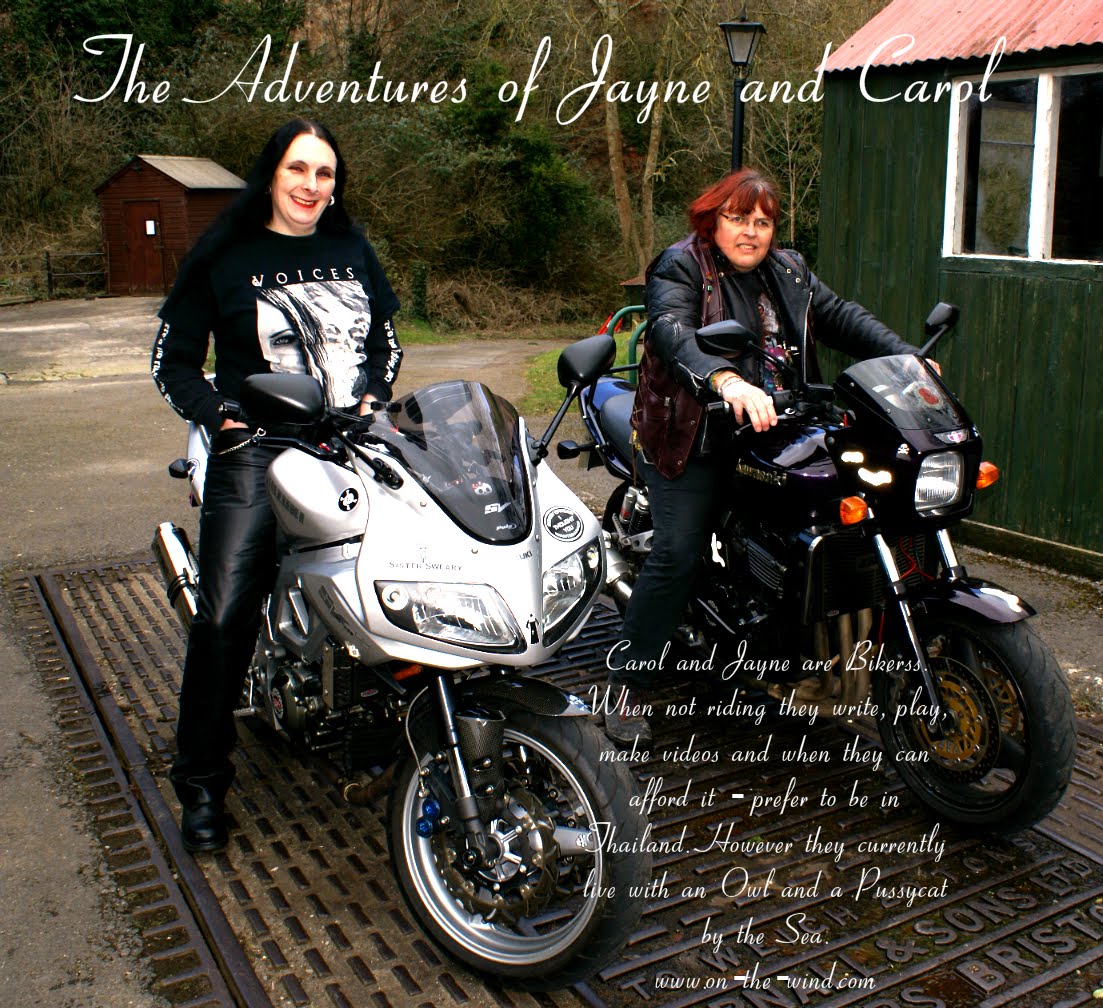ขออภัยสำหรับการแปลที่ไม่ดี รุ่นนี้ทำกับ Google แปลจากต้นฉบับภาษาอังกฤษ
เมื่อคุณได้ใช้เวลากว่า 30 ปีของการมีส่วนร่วมในการฝึกอบรมรถจักรยานยนต์ที่คุณคิดว่าทุกคนเห็นพ้องพื้นฐาน อย่างไรก็ตามในการอภิปรายที่ผ่านมาบนอินเทอร์เน็ตก็เป็นที่ชัดเจนว่าเทคนิคสำหรับการหยุดรถจักรยานยนต์ในกรณีฉุกเฉินที่ไม่ได้มาตรฐานที่ผมคาดไว้ นั่นทำให้ฉันเพื่อหารือเกี่ยวกับเรื่องนี้กับเพื่อนบางคนที่ไม่ได้รู้พื้นฐาน ฉันได้ใช้เวลาหลายปีในการสอนคนที่จะขี่จักรยานในสหราชอาณาจักร มันต้องใช้เวลากว่าห้าปีในการฝึกอบรมครูคนอื่น ๆ ที่จะทำหลักสูตรในการฝึกอบรมขั้นพื้นฐานได้เป็นอย่างดี ฉันประหลาดใจที่การขาดข้อมูลในสุทธิ
ในสหราชอาณาจักรที่เราได้รับการทำหลักสูตรการฝึกขั้นพื้นฐานเป็นเวลาหลายปี ครั้งแรกที่ผมได้เรียนรู้ที่จะขี่ขั้นตอนมาตรฐานสำหรับการหยุดฉุกเฉิน ต่อมาเมื่อผมสอนและเรียนรู้ทฤษฎีนั่งตำรวจขั้นสูงผ่านขี่สูงทุกอย่างเริ่มต้นที่จะทำให้รู้สึกว่าทำไมเราทำมันได้วิธีหนึ่ง ผมเข้าใจว่ามาตรฐานของเราที่มีความคล้ายคลึงกับส่วนที่เหลือของยุโรป ฉันรู้สึกประหลาดใจที่การขาดข้อมูลในสุทธิ
ดังนั้นผมจึงตัดสินใจที่จะลองและใช้ร่วมกับคุณในสิ่งที่เราได้รับการสอนในแอสฟัลต์เป็นเวลาหลายปี
ผมไม่ได้บอกทุกคนที่ไม่ได้ทำมันด้วยวิธีนี้เป็นสิ่งที่ผิด บรรทัดล่างนี่เป็นประสบการณ์ที่ดีที่สุดขึ้นอยู่กับประสบการณ์ของพวกเขาและการฝึกอบรม 'นี้ไม่ได้มุ่งเป้าไปที่มืออาชีพที่มีเทคนิคที่สมบูรณ์แบบ ผมไม่ได้อยู่ที่นี่เพื่อบอกผู้ที่รู้ดีกว่า ถ้ามีคนเพียงแค่บอกคุณสิ่งที่ฉันพูดผิดแล้วไปและพยายามด้วยตัวคุณเอง การปฏิบัติในการหาสิ่งที่เหมาะกับคุณ
สิ่งที่สำคัญคือการปฏิบัติ
นี้ไม่ได้เกี่ยวกับการควบคุมการเบรก แม้ว่าเราจะสัมผัสกับบางแง่มุมของมันนี้เป็นเกี่ยวกับการนำจักรยานไปที่ป้ายที่ไม่มีความตั้งใจที่อื่น ๆ กว่าที่จะหยุดการให้เร็วที่สุดเท่าที่จะทำได้ ฉันได้เห็นมันเป็นที่ถกเถียงกันว่าหยุดฉุกเฉินหนึ่งในสิ่งแรกที่ต้องทำคือดึงในคลัทช์ เมื่อผมถามว่าทำไมเป็นกรณีนี้คำตอบที่ได้รับ "ดังนั้นผู้ขับขี่สามารถเปลี่ยนเกียร์เพื่อที่ว่าเมื่อจักรยานลงผ่านมันในเกียร์แรก. พร้อมที่จะนั่ง"
ขยะ! ในการหยุดจักรยานจากสามสิบไมล์ต่อชั่วโมงก็จะใช้เวลาน้อยกว่าสามวินาที ตราบใดที่คุณให้ความสนใจคุณสามารถใช้จักรยานจากหยุดนิ่งที่จะ 60mph ในหกวินาทีหรือน้อยกว่า ถ้ามีคนดึงคลัทช์ในรถจักรยานยนต์ที่ 60mph ในกรณีฉุกเฉินใด ๆ และพยายามที่จะผิดพลาดลงผ่านเกียร์ในเวลาน้อยกว่าหกวินาทีและคาดหวังว่าตัวเองจะอยู่ในเกียร์แรกเมื่อพวกเขาหยุด ผมขอแนะนำให้พวกเขาไปนั่งรอบบล็อกและพยายามที่จะทำเช่นนั้นจริง
รถจักรยานยนต์เกียร์ synchromesh ชอบที่จะผลักดันในช่วงการเปลี่ยนแปลง มันช่วยให้พวกเขาที่จะเลือกจักรยานเก่าอังกฤษมีแนวโน้มที่จะปล่อยให้นอนอยู่ระหว่างเกียร์ โชคดีที่ไม่ได้เลวร้ายเกี่ยวกับจักรยานที่ทันสมัยคุณมีแนวโน้มที่จะพบพวกเขาเมื่อคุณไม่ได้ใช้เกียร์ได้อย่างถูกต้อง มีเหตุผลอื่น ๆ ไม่ได้ที่จะดึงคลัทช์ในเช่นกัน ซึ่งการที่เราจะกลับมา
วันนี้มีจักรยานจำนวนมากที่ติดตั้งระบบเบรกป้องกันล้อล็อก (ABS) เป็นสิ่งที่ดี อย่างไรก็ตามเทคนิคที่ใช้ในการหยุดจักรยานด้วย ABS ไม่แตกต่างกันเล็กน้อย แต่พื้นฐานเดียวกันอ้างถึงคำแนะนำของผู้ผลิต!
ดังนั้นคุณจะเดินทางไปและเด็กวิ่งออกมาในหน้าของคุณ วิธีที่เร็วที่สุดที่จะหยุด?
สิ่งแรกที่ต้องทำคือการปิดคันเร่ง นี้จะเกิดขึ้นเร็วที่สุดเท่าที่เป็นไปได้ถ้าคุณกำลังขี่จับ หนึ่งในเหตุผลนี้ถูกค้นพบเมื่อหลายปีที่ผ่านมาและสามารถมองเห็นได้ในกีฬาที่ทันสมัยจักรยาน - ผลักดันฉัน - ดึงการติดตั้งสายคันเร่งของคุณ คุณไม่จำเป็นต้องสองทำไม? มีเพียงคนเดียวรถจักรยานยนต์เก่า 'ดึงเพื่อเปิดสายคันเร่งออกจากที่อยู่อาศัยเค้นในฤดูใบไม้ผลิ แต่แล้วมันถูกค้นพบคุณสามารถปิดการเร่งได้เร็วขึ้นด้วยมือ
อะไรคือสิ่งที่เห็นได้ชัดเมื่อคุณมองออกไปบนถนนลาดยางขี่ผู้สมัครทดสอบในการฝึกการหยุดฉุกเฉินเป็นปัญหาอื่น ๆ ที่มีคนขี่รถครอบคลุม ในสถานการณ์ฉุกเฉินที่พวกเขาไปสำหรับเบรค แต่จะไม่ปล่อยคันเร่งแก้ไขบางอย่างแย่ลงยังคงหมุนรอบเครื่องยนต์เมื่อเบรกโลภ นี้จะได้รับการแก้ไขในเร็ว ๆ นี้กับการปฏิบัติ แต่การปฏิบัติมีการถือครองบาร์เมื่อไม่ได้ใช้เบรกหรือคลัทช์ มันเป็นเรื่องที่จะอยู่ในสหราชอาณาจักรคือการทดสอบที่ครอบคลุมขี่เบรกหมายความว่าคุณจะไม่ถือบาร์และดังนั้นจึงไม่ได้อย่างเต็มที่ในการควบคุมของจักรยาน
ดังนั้นคุณปิดเค้นและความก้าวหน้าที่เริ่มต้นที่จะใช้เบรก ที่นี่เราใช้การอ้างอิงของปืน ตอนนี้ผมรู้ว่าทุกคนไม่ได้มีประสบการณ์ในการถ่ายภาพ แต่คนส่วนใหญ่ได้ดูสกปรกแฮร์รี่ 'ภาพยนตร์หรือสิ่งที่ต้องการหรือเห็น' เด็ก 'ได้รับการถ่ายภาพการเรียนการสอนที่ได้รับการบอกว่า "ไม่ได้ดึงบีบ" ในทริกเกอร์สำหรับปืนก็อาจหมายถึงการเปิดออกไปและหายไปเป้าหมาย ในรถจักรยานยนต์นี้เป็นเพราะสิ่งสุดท้ายที่เราต้องการคือการหลวมฉุดกับถนนและฉกคันโยกเพื่อล็อคล้อพอที่จะบีบวาด
มากที่สุดของรถจักรยานยนต์สามารถทำได้ด้วยการเบรกล้อหน้า ตราบใดที่จักรยานเป็นตรงและคุณมีผู้ผลิตยางรถยนต์ฉุดดีบางอย่างพูดได้ถึง 90% ไปด้านหน้า ในขณะที่คุณใช้เบรกส่วนใหญ่ของน้ำหนักและน้ำหนักจักรยานของคุณถูกโอนไปยังล้อหน้าไปข้างหน้า แต่ตอนนี้ยังทำให้ด้านหลังของจักรยานที่จะยก บางคนบอกว่านี่เป็นข้อโต้แย้งที่ไม่ได้ใช้เบรกหลังที่ทุกคน ในหยุดฉุกเฉินเรากำลังจะสูญเสียการควบคุมของล้อ ที่สำคัญเราใช้ fractionally เร็วกว่าด้านหลัง นี้คือการได้รับการโอนเงินครั้งแรกของน้ำหนักที่ล้อหน้า
เมื่อล้อสูญเสียการติดต่อกับถนนมันจะไร้ค่า ด้วยการใช้การควบคุมเบรกขั้นสูง (และความอุดมสมบูรณ์ของการปฏิบัติ) มันเป็นเรื่องง่ายที่จะใช้จักรยานเพื่อหยุดที่สมบูรณ์แม้จะมาจากความเร็วสูง, การเก็บรักษายางในการติดต่อและการยึดเกาะถนน
นี่คือวิธีที่ดีที่สุดที่จะหยุดในระยะทางที่สั้นที่สุด
ปิดเค้น แต่การรักษาคลัทช์ส่วนร่วมจะช่วยให้เบรกเครื่องยนต์ที่ใช้ ตอนนี้บางคนจะพูดแบบนี้เป็น overkill แต่ยังโบนัส; กับเครื่องยนต์ยังคงขับรถก็มีผลกระทบจากการหยุดล้อหลังลื่นไถลได้ง่ายในขณะที่ความก้าวหน้าลดความเร็ว
เบรกด้านหลังยังจะมีผลกระทบบางส่วน การรักษาของล้อด้านหลังบนพื้นดินที่มีเบรกเท้าและเครื่องยนต์และดึงจักรยานกลับลงมาและทำให้เวลาสั้นหยุดอย่างเห็นได้ชัด
ความสามารถในการเบรกสูงสุดจะทำได้โดยการรักษาทั้งสองล้อเพียงสั้น ๆ ของการล็อกและลื่นไถลออก
(มันเป็นข้อสังเกตว่าใน Roadcraft เป็นยาง 15%. แต่ที่ใช้เวลาการปฏิบัติน้อยและจำนวนมากของเส้นประสาท.)
ฉันมีเพื่อนที่มีกีฬาจักรยานได้ตัดสินใจที่จะพอดีกับรถสองคันดำเนินการในคลัทช์และเบรค พวกเขาให้เหตุผลต่างๆในการอ้างสิทธิ์ปฏิกิริยาที่ดีและสิ่งที่ ผมไม่ได้ที่นี่ที่จะบอกคุณว่ามันเป็นพวกเขาหรือไม่ถูกต้อง ฉันทั้งหมดสำหรับทุกคนมีอิสระที่จะเลือก อย่างไรก็ตามสาเหตุของทั้งสี่นิ้วมือโดยเฉพาะอย่างยิ่งเมื่อมีการใช้คันโยกมาตรฐานจะถูกบันทึกไว้อย่างดี
ถ้าคุณอยู่ในนิสัยของการใช้เพียง 2 คันนิ้วมือแล้วโอกาสที่คุณจะไปที่จะเบรกในสถานการณ์ฉุกเฉินในลักษณะเดียวกับที่คุณมักจะทำ - ด้วยสองนิ้ว
ซึ่งหมายความว่าคันมาตรฐานที่มี 2 นิ้วมือยังคงอยู่ข้างหลังรถได้เป็นอย่างดี มีหลายกรณีที่นิ้วมือถูกบดระหว่างรถและบาร์ ไม่ว่าจะเป็นจักรยานฮิตถนนหรือวัตถุอื่น ๆ นอกจากนี้ยังสามารถนำไปสู่การ จำกัด การเคลื่อนไหวของคันโยก
ความสุขที่กลับมาเท่าที่จับเบรก บางทีในกีฬาจักรยานจัดเตรียมไว้สำหรับการติดตามคุณสามารถตรวจสอบทุกอย่างเป็นที่สมบูรณ์แบบ (ครูส่วนใหญ่ยังคงต้องการที่จะติดตามนิ้วมือของคุณทั้งสี่เบรก!) แต่หลังจากชั่วโมงหรือในประเพณีการขี่จักรยานถนนเปิดไม่ได้รับการสนับสนุนโดย บางทีอาจจะเป็นทีมที่ไม่ถูกต้อง หลังจากนั่งที่ดีหรือใช้เบรกได้รับความร้อนและหนัก น้ำมันเบรกเป็น hydroscopic (ดูดซับน้ำของเหลว) พวกเขาสามารถจางหายไปในน้ำเดือดพวกเขาสวมใส่ หลายเหตุผลที่สามารถทำให้เกิดการเบรกไม่ทำงานอย่างถูกต้อง ในกรณีที่คุณต้องการที่จะเสี่ยงของการเกิดอุบัติเหตุ?
มีเหตุผลอื่น ๆ เช่นกันสำหรับการนั่งไม่ได้มีหน่วยความคุ้มครอง ส่วนที่เหลือนิ้วมือของคุณบนคันอาจทำให้เกิดการสึกหรอของบานพับและแม่ปั๊มลูกสูบ นอกจากนี้สิ่งที่แม้แต่สามเณรไปยังจุดต่อไปนี้เมื่อ - ไฟเบรกกระพริบสาเหตุที่พบบ่อยสำหรับการทดสอบอังกฤษล้มเหลวเช่นกัน
มันได้รับการกล่าวว่าการขี่ในเมืองที่มีจำนวนมากของยานพาหนะในพื้นที่ขนาดเล็กที่ครอบคลุมเบรกหน้าเป็นวิธีที่ดีที่สุดที่จะขี่ "ดังนั้นคุณจึงสามารถตอบสนองได้อย่างรวดเร็ว" แม้ว่าเมืองจะได้รับใกล้แออัดมากขึ้นและส่วนตัวผมชอบที่จะลองและจัดหาพื้นที่ปลอดภัยรอบตัวเองไม่จำเป็นต้องให้ฉันเพื่อให้ครอบคลุมเบรก ในเมืองความเร็วช้าจริงๆในการหลบหลีกความเร็วช้ารอบคนเดินเท้าและผู้ใช้ถนนอื่น ๆ เค้นควบคุมความเร็วช้า / คลัทช์ / เบรกหลังเป็นวิธีที่เหมาะกับสภาพแวดล้อม
ดังนั้นหากคุณต้องการที่จะฝึกที่นี่เป็นรายการตรวจสอบ รับเพื่อนที่จะช่วยให้ไปที่พื้นที่ที่เงียบสงบโดยเฉพาะอย่างยิ่งกับเด็กเล่นและการ จำกัด ความเร็วที่สูงขึ้น รับคู่ของคุณจะดูหลังของคุณและเพียงแค่ให้คุณสัญญาณที่จะหยุดได้อย่างปลอดภัย เมื่อคู่ของคุณลงก่อนแล้ว: -
หยุดฉุกเฉิน
1 / ปิดเค้น
2 / เบรก
3 / กลับเบรก (ช่วงเวลาหลังจากที่ด้านหน้า)
4 / บีบวาด!
5 / ก้าวหน้าหนักจนความเร็วจะหายไปแล้วกลับมานั่งเล็ก ๆ น้อย ๆ ในขั้นตอนต่อมาก่อนที่คุณจะหยุด (I เนื่องจากกองกำลังที่ผสมผสานกันอย่างลงตัวของความเร็วที่ได้รับการสูญเสียและเพิ่มความเสี่ยง. ล้อหน้าลื่นไถลด้านล่างนี้ )
6 / พยายามที่จะทำทุกการเบรกของคุณกับจักรยานตรงและเป็นเส้นตรง
7 / ปล่อยคลัทช์เพียงอย่างเดียวไม่ต้องกังวลเกี่ยวกับเรื่องนี้ หยุดกังวลเกี่ยวกับ
8 / เมื่อคุณมีหยุดฉุกเฉิน - มองอยู่ข้างหลังคุณ!
เมื่อคุณได้ใช้เวลากว่า 30 ปีของการมีส่วนร่วมในการฝึกอบรมรถจักรยานยนต์ที่คุณคิดว่าทุกคนเห็นพ้องพื้นฐาน อย่างไรก็ตามในการอภิปรายที่ผ่านมาบนอินเทอร์เน็ตก็เป็นที่ชัดเจนว่าเทคนิคสำหรับการหยุดรถจักรยานยนต์ในกรณีฉุกเฉินที่ไม่ได้มาตรฐานที่ผมคาดไว้ นั่นทำให้ฉันเพื่อหารือเกี่ยวกับเรื่องนี้กับเพื่อนบางคนที่ไม่ได้รู้พื้นฐาน ฉันได้ใช้เวลาหลายปีในการสอนคนที่จะขี่จักรยานในสหราชอาณาจักร มันต้องใช้เวลากว่าห้าปีในการฝึกอบรมครูคนอื่น ๆ ที่จะทำหลักสูตรในการฝึกอบรมขั้นพื้นฐานได้เป็นอย่างดี ฉันประหลาดใจที่การขาดข้อมูลในสุทธิ
ในสหราชอาณาจักรที่เราได้รับการทำหลักสูตรการฝึกขั้นพื้นฐานเป็นเวลาหลายปี ครั้งแรกที่ผมได้เรียนรู้ที่จะขี่ขั้นตอนมาตรฐานสำหรับการหยุดฉุกเฉิน ต่อมาเมื่อผมสอนและเรียนรู้ทฤษฎีนั่งตำรวจขั้นสูงผ่านขี่สูงทุกอย่างเริ่มต้นที่จะทำให้รู้สึกว่าทำไมเราทำมันได้วิธีหนึ่ง ผมเข้าใจว่ามาตรฐานของเราที่มีความคล้ายคลึงกับส่วนที่เหลือของยุโรป ฉันรู้สึกประหลาดใจที่การขาดข้อมูลในสุทธิ
ดังนั้นผมจึงตัดสินใจที่จะลองและใช้ร่วมกับคุณในสิ่งที่เราได้รับการสอนในแอสฟัลต์เป็นเวลาหลายปี
ผมไม่ได้บอกทุกคนที่ไม่ได้ทำมันด้วยวิธีนี้เป็นสิ่งที่ผิด บรรทัดล่างนี่เป็นประสบการณ์ที่ดีที่สุดขึ้นอยู่กับประสบการณ์ของพวกเขาและการฝึกอบรม 'นี้ไม่ได้มุ่งเป้าไปที่มืออาชีพที่มีเทคนิคที่สมบูรณ์แบบ ผมไม่ได้อยู่ที่นี่เพื่อบอกผู้ที่รู้ดีกว่า ถ้ามีคนเพียงแค่บอกคุณสิ่งที่ฉันพูดผิดแล้วไปและพยายามด้วยตัวคุณเอง การปฏิบัติในการหาสิ่งที่เหมาะกับคุณ
สิ่งที่สำคัญคือการปฏิบัติ
นี้ไม่ได้เกี่ยวกับการควบคุมการเบรก แม้ว่าเราจะสัมผัสกับบางแง่มุมของมันนี้เป็นเกี่ยวกับการนำจักรยานไปที่ป้ายที่ไม่มีความตั้งใจที่อื่น ๆ กว่าที่จะหยุดการให้เร็วที่สุดเท่าที่จะทำได้ ฉันได้เห็นมันเป็นที่ถกเถียงกันว่าหยุดฉุกเฉินหนึ่งในสิ่งแรกที่ต้องทำคือดึงในคลัทช์ เมื่อผมถามว่าทำไมเป็นกรณีนี้คำตอบที่ได้รับ "ดังนั้นผู้ขับขี่สามารถเปลี่ยนเกียร์เพื่อที่ว่าเมื่อจักรยานลงผ่านมันในเกียร์แรก. พร้อมที่จะนั่ง"
ขยะ! ในการหยุดจักรยานจากสามสิบไมล์ต่อชั่วโมงก็จะใช้เวลาน้อยกว่าสามวินาที ตราบใดที่คุณให้ความสนใจคุณสามารถใช้จักรยานจากหยุดนิ่งที่จะ 60mph ในหกวินาทีหรือน้อยกว่า ถ้ามีคนดึงคลัทช์ในรถจักรยานยนต์ที่ 60mph ในกรณีฉุกเฉินใด ๆ และพยายามที่จะผิดพลาดลงผ่านเกียร์ในเวลาน้อยกว่าหกวินาทีและคาดหวังว่าตัวเองจะอยู่ในเกียร์แรกเมื่อพวกเขาหยุด ผมขอแนะนำให้พวกเขาไปนั่งรอบบล็อกและพยายามที่จะทำเช่นนั้นจริง
รถจักรยานยนต์เกียร์ synchromesh ชอบที่จะผลักดันในช่วงการเปลี่ยนแปลง มันช่วยให้พวกเขาที่จะเลือกจักรยานเก่าอังกฤษมีแนวโน้มที่จะปล่อยให้นอนอยู่ระหว่างเกียร์ โชคดีที่ไม่ได้เลวร้ายเกี่ยวกับจักรยานที่ทันสมัยคุณมีแนวโน้มที่จะพบพวกเขาเมื่อคุณไม่ได้ใช้เกียร์ได้อย่างถูกต้อง มีเหตุผลอื่น ๆ ไม่ได้ที่จะดึงคลัทช์ในเช่นกัน ซึ่งการที่เราจะกลับมา
วันนี้มีจักรยานจำนวนมากที่ติดตั้งระบบเบรกป้องกันล้อล็อก (ABS) เป็นสิ่งที่ดี อย่างไรก็ตามเทคนิคที่ใช้ในการหยุดจักรยานด้วย ABS ไม่แตกต่างกันเล็กน้อย แต่พื้นฐานเดียวกันอ้างถึงคำแนะนำของผู้ผลิต!
ดังนั้นคุณจะเดินทางไปและเด็กวิ่งออกมาในหน้าของคุณ วิธีที่เร็วที่สุดที่จะหยุด?
สิ่งแรกที่ต้องทำคือการปิดคันเร่ง นี้จะเกิดขึ้นเร็วที่สุดเท่าที่เป็นไปได้ถ้าคุณกำลังขี่จับ หนึ่งในเหตุผลนี้ถูกค้นพบเมื่อหลายปีที่ผ่านมาและสามารถมองเห็นได้ในกีฬาที่ทันสมัยจักรยาน - ผลักดันฉัน - ดึงการติดตั้งสายคันเร่งของคุณ คุณไม่จำเป็นต้องสองทำไม? มีเพียงคนเดียวรถจักรยานยนต์เก่า 'ดึงเพื่อเปิดสายคันเร่งออกจากที่อยู่อาศัยเค้นในฤดูใบไม้ผลิ แต่แล้วมันถูกค้นพบคุณสามารถปิดการเร่งได้เร็วขึ้นด้วยมือ
อะไรคือสิ่งที่เห็นได้ชัดเมื่อคุณมองออกไปบนถนนลาดยางขี่ผู้สมัครทดสอบในการฝึกการหยุดฉุกเฉินเป็นปัญหาอื่น ๆ ที่มีคนขี่รถครอบคลุม ในสถานการณ์ฉุกเฉินที่พวกเขาไปสำหรับเบรค แต่จะไม่ปล่อยคันเร่งแก้ไขบางอย่างแย่ลงยังคงหมุนรอบเครื่องยนต์เมื่อเบรกโลภ นี้จะได้รับการแก้ไขในเร็ว ๆ นี้กับการปฏิบัติ แต่การปฏิบัติมีการถือครองบาร์เมื่อไม่ได้ใช้เบรกหรือคลัทช์ มันเป็นเรื่องที่จะอยู่ในสหราชอาณาจักรคือการทดสอบที่ครอบคลุมขี่เบรกหมายความว่าคุณจะไม่ถือบาร์และดังนั้นจึงไม่ได้อย่างเต็มที่ในการควบคุมของจักรยาน
ดังนั้นคุณปิดเค้นและความก้าวหน้าที่เริ่มต้นที่จะใช้เบรก ที่นี่เราใช้การอ้างอิงของปืน ตอนนี้ผมรู้ว่าทุกคนไม่ได้มีประสบการณ์ในการถ่ายภาพ แต่คนส่วนใหญ่ได้ดูสกปรกแฮร์รี่ 'ภาพยนตร์หรือสิ่งที่ต้องการหรือเห็น' เด็ก 'ได้รับการถ่ายภาพการเรียนการสอนที่ได้รับการบอกว่า "ไม่ได้ดึงบีบ" ในทริกเกอร์สำหรับปืนก็อาจหมายถึงการเปิดออกไปและหายไปเป้าหมาย ในรถจักรยานยนต์นี้เป็นเพราะสิ่งสุดท้ายที่เราต้องการคือการหลวมฉุดกับถนนและฉกคันโยกเพื่อล็อคล้อพอที่จะบีบวาด
มากที่สุดของรถจักรยานยนต์สามารถทำได้ด้วยการเบรกล้อหน้า ตราบใดที่จักรยานเป็นตรงและคุณมีผู้ผลิตยางรถยนต์ฉุดดีบางอย่างพูดได้ถึง 90% ไปด้านหน้า ในขณะที่คุณใช้เบรกส่วนใหญ่ของน้ำหนักและน้ำหนักจักรยานของคุณถูกโอนไปยังล้อหน้าไปข้างหน้า แต่ตอนนี้ยังทำให้ด้านหลังของจักรยานที่จะยก บางคนบอกว่านี่เป็นข้อโต้แย้งที่ไม่ได้ใช้เบรกหลังที่ทุกคน ในหยุดฉุกเฉินเรากำลังจะสูญเสียการควบคุมของล้อ ที่สำคัญเราใช้ fractionally เร็วกว่าด้านหลัง นี้คือการได้รับการโอนเงินครั้งแรกของน้ำหนักที่ล้อหน้า
เมื่อล้อสูญเสียการติดต่อกับถนนมันจะไร้ค่า ด้วยการใช้การควบคุมเบรกขั้นสูง (และความอุดมสมบูรณ์ของการปฏิบัติ) มันเป็นเรื่องง่ายที่จะใช้จักรยานเพื่อหยุดที่สมบูรณ์แม้จะมาจากความเร็วสูง, การเก็บรักษายางในการติดต่อและการยึดเกาะถนน
นี่คือวิธีที่ดีที่สุดที่จะหยุดในระยะทางที่สั้นที่สุด
ปิดเค้น แต่การรักษาคลัทช์ส่วนร่วมจะช่วยให้เบรกเครื่องยนต์ที่ใช้ ตอนนี้บางคนจะพูดแบบนี้เป็น overkill แต่ยังโบนัส; กับเครื่องยนต์ยังคงขับรถก็มีผลกระทบจากการหยุดล้อหลังลื่นไถลได้ง่ายในขณะที่ความก้าวหน้าลดความเร็ว
เบรกด้านหลังยังจะมีผลกระทบบางส่วน การรักษาของล้อด้านหลังบนพื้นดินที่มีเบรกเท้าและเครื่องยนต์และดึงจักรยานกลับลงมาและทำให้เวลาสั้นหยุดอย่างเห็นได้ชัด
ความสามารถในการเบรกสูงสุดจะทำได้โดยการรักษาทั้งสองล้อเพียงสั้น ๆ ของการล็อกและลื่นไถลออก
(มันเป็นข้อสังเกตว่าใน Roadcraft เป็นยาง 15%. แต่ที่ใช้เวลาการปฏิบัติน้อยและจำนวนมากของเส้นประสาท.)
ฉันมีเพื่อนที่มีกีฬาจักรยานได้ตัดสินใจที่จะพอดีกับรถสองคันดำเนินการในคลัทช์และเบรค พวกเขาให้เหตุผลต่างๆในการอ้างสิทธิ์ปฏิกิริยาที่ดีและสิ่งที่ ผมไม่ได้ที่นี่ที่จะบอกคุณว่ามันเป็นพวกเขาหรือไม่ถูกต้อง ฉันทั้งหมดสำหรับทุกคนมีอิสระที่จะเลือก อย่างไรก็ตามสาเหตุของทั้งสี่นิ้วมือโดยเฉพาะอย่างยิ่งเมื่อมีการใช้คันโยกมาตรฐานจะถูกบันทึกไว้อย่างดี
ถ้าคุณอยู่ในนิสัยของการใช้เพียง 2 คันนิ้วมือแล้วโอกาสที่คุณจะไปที่จะเบรกในสถานการณ์ฉุกเฉินในลักษณะเดียวกับที่คุณมักจะทำ - ด้วยสองนิ้ว
ซึ่งหมายความว่าคันมาตรฐานที่มี 2 นิ้วมือยังคงอยู่ข้างหลังรถได้เป็นอย่างดี มีหลายกรณีที่นิ้วมือถูกบดระหว่างรถและบาร์ ไม่ว่าจะเป็นจักรยานฮิตถนนหรือวัตถุอื่น ๆ นอกจากนี้ยังสามารถนำไปสู่การ จำกัด การเคลื่อนไหวของคันโยก
ความสุขที่กลับมาเท่าที่จับเบรก บางทีในกีฬาจักรยานจัดเตรียมไว้สำหรับการติดตามคุณสามารถตรวจสอบทุกอย่างเป็นที่สมบูรณ์แบบ (ครูส่วนใหญ่ยังคงต้องการที่จะติดตามนิ้วมือของคุณทั้งสี่เบรก!) แต่หลังจากชั่วโมงหรือในประเพณีการขี่จักรยานถนนเปิดไม่ได้รับการสนับสนุนโดย บางทีอาจจะเป็นทีมที่ไม่ถูกต้อง หลังจากนั่งที่ดีหรือใช้เบรกได้รับความร้อนและหนัก น้ำมันเบรกเป็น hydroscopic (ดูดซับน้ำของเหลว) พวกเขาสามารถจางหายไปในน้ำเดือดพวกเขาสวมใส่ หลายเหตุผลที่สามารถทำให้เกิดการเบรกไม่ทำงานอย่างถูกต้อง ในกรณีที่คุณต้องการที่จะเสี่ยงของการเกิดอุบัติเหตุ?
มีเหตุผลอื่น ๆ เช่นกันสำหรับการนั่งไม่ได้มีหน่วยความคุ้มครอง ส่วนที่เหลือนิ้วมือของคุณบนคันอาจทำให้เกิดการสึกหรอของบานพับและแม่ปั๊มลูกสูบ นอกจากนี้สิ่งที่แม้แต่สามเณรไปยังจุดต่อไปนี้เมื่อ - ไฟเบรกกระพริบสาเหตุที่พบบ่อยสำหรับการทดสอบอังกฤษล้มเหลวเช่นกัน
มันได้รับการกล่าวว่าการขี่ในเมืองที่มีจำนวนมากของยานพาหนะในพื้นที่ขนาดเล็กที่ครอบคลุมเบรกหน้าเป็นวิธีที่ดีที่สุดที่จะขี่ "ดังนั้นคุณจึงสามารถตอบสนองได้อย่างรวดเร็ว" แม้ว่าเมืองจะได้รับใกล้แออัดมากขึ้นและส่วนตัวผมชอบที่จะลองและจัดหาพื้นที่ปลอดภัยรอบตัวเองไม่จำเป็นต้องให้ฉันเพื่อให้ครอบคลุมเบรก ในเมืองความเร็วช้าจริงๆในการหลบหลีกความเร็วช้ารอบคนเดินเท้าและผู้ใช้ถนนอื่น ๆ เค้นควบคุมความเร็วช้า / คลัทช์ / เบรกหลังเป็นวิธีที่เหมาะกับสภาพแวดล้อม
ดังนั้นหากคุณต้องการที่จะฝึกที่นี่เป็นรายการตรวจสอบ รับเพื่อนที่จะช่วยให้ไปที่พื้นที่ที่เงียบสงบโดยเฉพาะอย่างยิ่งกับเด็กเล่นและการ จำกัด ความเร็วที่สูงขึ้น รับคู่ของคุณจะดูหลังของคุณและเพียงแค่ให้คุณสัญญาณที่จะหยุดได้อย่างปลอดภัย เมื่อคู่ของคุณลงก่อนแล้ว: -
หยุดฉุกเฉิน
1 / ปิดเค้น
2 / เบรก
3 / กลับเบรก (ช่วงเวลาหลังจากที่ด้านหน้า)
4 / บีบวาด!
5 / ก้าวหน้าหนักจนความเร็วจะหายไปแล้วกลับมานั่งเล็ก ๆ น้อย ๆ ในขั้นตอนต่อมาก่อนที่คุณจะหยุด (I เนื่องจากกองกำลังที่ผสมผสานกันอย่างลงตัวของความเร็วที่ได้รับการสูญเสียและเพิ่มความเสี่ยง. ล้อหน้าลื่นไถลด้านล่างนี้ )
6 / พยายามที่จะทำทุกการเบรกของคุณกับจักรยานตรงและเป็นเส้นตรง
7 / ปล่อยคลัทช์เพียงอย่างเดียวไม่ต้องกังวลเกี่ยวกับเรื่องนี้ หยุดกังวลเกี่ยวกับ
8 / เมื่อคุณมีหยุดฉุกเฉิน - มองอยู่ข้างหลังคุณ!



